Controverscial.Com
![]()
Welcome
![]()
|
Controverscial.Com
Welcome
|
|
|
Controverscial.Com
Welcome
|



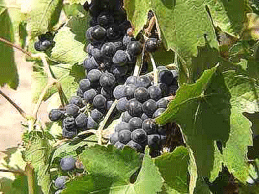
The Vine
tree or Grapevine (Vitis vinifera) is more of a shrub-plant than a tree,
but never the less as one of the oldest cultivated plants in the world.
The Vine is sacred
to Wicca and Witchcraft, and of old was revered by our ancestors.
According to the Celtic Tree calendar the Vine represents the
tenth month of the year (2nd Sept – 29th Sept), which
includes the celebration of “Mabon” - the Autumn Equinox on the 22nd
Sept.
Vines are a long living plants, which have been used by
man since civilization
began; likewise wines produced from its grapes has long been a universal drink.
Fossilized leaves, seeds and stems of the grapevine, some of them thought
to be 40 million years old, have been found in ancient sites throughout the
Northern Hemisphere, and in the Burgundy region of France there are still living
vines said to be over 400 years old.
Egyptian
hieroglyphics showing details of grape vines and how to making wine have been
discovered, some dating from about 2400 BC, while seeds from the grape have been
found entombed with Egyptian mummies at least 3,000 years old.
Wine making was also a regular part of ancient Greek life and Pliny the
Elder speaks of a vines supposedly 600 years old.
In old Christian scriptures, Noah is said to have planted a vineyard
after he survived the great flood.
The name
of the Vine is derived from the Latin word “viere”, meaning to twist, which
is descriptive of the growing habits of the plant. Grape vines are native to northern temperate zones, but are
cultivated throughout the world by the winemaking industry.
Today there are some 65 species of Vines producing more than 8,000
varieties of grapes. France, Spain
and Italy cultivate the most acreage of grapes, followed by Turkey and Georgia.
Other major grape-producing countries are:
Algeria, Argentina, Greece, Hungary, Portugal, Romania and the United
States. Australia, Bulgaria, Chile,
Germany, Syria and South Africa, also produce a large part of the world’s
grape market.
Grapevines
will grow in many different kinds of soil, but the soil must have a certain
depth and drain well, soil of a volcanic nature produces the finest wines.
A common method of propagation is to plant cuttings taken from mature
vines. Another method is known as
layering. This is done by bending
down a branch of a mature vine and forcing it to grow along a shallow trench in
the ground. After shoots start to
grow upward from the buds on the branch, the trench is filled with soil.
The shoots then develop roots and by winter the shoots and their roots
are ready to be cut from the parent branch.
In the spring they can be planted as new grapevines.
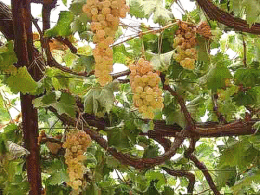
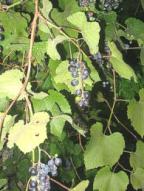
Left untended vines will grow up to 15 meters high and
climb anything that will give them support.
Their leaves are generally large flat and lobed, and depending on species can be deeply
indented or have jagged serrated margins. Their
flowers normally appear in May/June, followed by bunches of grapes that ripen in
the late summer Aug/Sept. The
grape consists of a watery fleshy pulp containing stones encased in a soft skin.
They can be differentiated by their skin colors, which range from pale
green to yellow, to red, to purple or black, while some varieties are even
multicolored.
The vine
has little other use then that of winemaking.
Of the 65 species of vines and more than 8,000 varieties of grapes, only
one species is used for nearly all the wine made in the world, the (Vitis
vinifera) species, often called the “World Grape”.
From this one species as many as 4,000 varieties of grape have been
developed, but only about a dozen of these are commonly used for making wine.
Among the chief varieties of those used are:
Riesling, Chardonnay, Cabernet Sauvignon, Pinot Noir, Gewurztraminer,
Sauvignon Blanc and Muscat.
Wine is
made by allowing the grape juice to ferment.
To aid the fermentation process, yeast (usually Saccharomyces) is
added to convert the sugars to alcohol. Fermentation
usually takes place in large vats from which the air is excluded to prevent
oxidation and to discourage the growth of vinegar-forming bacteria.
Normally fermentation takes from ten to 30 days, during which the
temperature is controlled to promote yeast growth and to extract the flavors and
colors from the skins. Artificial
heat for this process was not used until the early part of the last century, and
the first accounts of vineries enclosed by glass date from the middle of that
period.
After
the fermentation process is done, the wine is racked (drawn off) to separate it
from the lees (the dregs or sediment). Some
wines deposit their sediment quickly, but other wines remain cloudy for long
periods. The wine then goes through
several clarification processes before being stored and aged in wooden
containers made of Oak or Redwood. This
aging process allows oxygen to enter and water and alcohol to escape.
During this time the acidity decreases and additional clarification takes
place. The wood from the container
also contributes too and enhances the flavor and aroma of the wine.
The wood-aging process may last many months or even several years, all
depending on the wine and the quality desired.
Some
wines are aged in bottles before being sold.
Red wines in particular may profit from two to twenty years of bottle
aging. Wine quality and diversity
comes not just from the variety of grape, but also from the quality of the soil
it is grown in, as well as climatic conditions.
Changes in weather patterns from one year to the next can have a
tremendous influence on the quality of its vintage. In addition each wine grower or vintager may have different
techniques and methods of producing wine, which they keep secret so that no one
else can copy and use it.
In Greek mythology Dionysus
is the God of Nature, and the God of Wine and Inspiration (and later personified
by the Roman god Bacchus). As
Dionysus, he was also the God of Ecstasy and his cult was one of the mystery
religions. He produced the first
wine from the vine, and spread the art of tending grapes, but he also had a dual
side to his nature, on the one hand he could bring about joy and divine ecstasy
and on the other hand brutal unthinking rage, both reflecting the nature of
wine.
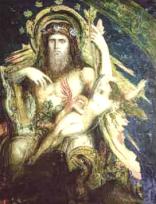
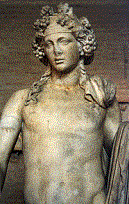

Dionysus
is the son of Zeus and Semele (a mortal women), the only god to have a mortal
parent. In legend, Zeus came to
Semele in the night invisible, and she knew him only as a divine presence.
Semele was pleased to be a lover of a god even though she did not know
which god he was. However word of
his infidelity soon spread and his wife Hera quickly learned who she was.
Hera confronted Semele in disguise, and convinced her to see who her
lover really was. When Zeus next
went to visit her, she made him promise and swear on the River Styx that he
would reveal himself.
She
being a mortal Zeus knew what would happen, but he was madly in love with her
and couldn’t refuse. When he did
reveal his true form, Semele was instantly struck dead by the sight of all his
glory. Zeus then took their unborn
child Dionysus from her womb and sewed him into his thigh till he was ready to
be born. After due time Dionysus
emerged from his thigh perfectly formed and became known as “the twice-born
god” associated with death and rebirth.
Dionysus
was one of the few gods able to appease Hades and bring a dead person back from
the underworld. Even though he had
never known his mother Semele, after her death he descended into the underworld
in an effort to bring her back. Hades
normally reluctant to release the dead, would only agreed to allow Semele back
if Dionysus could exchange something important to life.
So Dionysus gave him the myrtle plant.
(The Myrtle plant was associated Aphrodite, the Goddess of Love
and the guardian of birth and rebirth, and is the symbol of new beginnings and
new life).
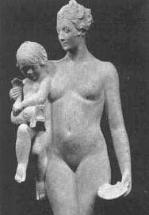
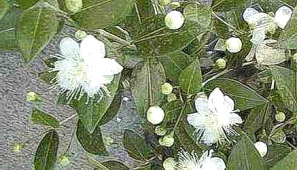
Dionysus
wandered the world accompanied by Maenads, actively encouraging his cult and his
worship. The Maenads were wild
women often flush with wine, their shoulders draped with fawn skins and carrying
hazel wands tipped with pinecones. While
other gods erected temples for their worship, the followers of Dionysus
worshipped in the woods. There they
worked themselves up into states of frenzied ecstasy, and any animals they
happened upon would be rip apart in sacrifice, their flesh eaten raw.
As Bacchus he was accompanied Bacchantes, a similar band of female
worshippers who also roamed the forests dressed in animal skins.
Dionysus
became one of the most important gods in everyday Greek life, and was associated
with several key concepts. His
association with death and rebirth can be seen symbolically in tending vines.
Each year the vines are pruned back sharply and left to become dormant
through the winter, ready to bear fruit in the following spring.
Another concept is that under the influence of wine we can connect with
nature. In the mystery traditions
intoxication comes not from the plant but from the spirit of the plant, the
divine essence, under which we become free and liberated from constraints placed
upon us by formal society. At these
times a man might become greater then himself and do works he otherwise would
not.
In
ancient times the festival of Dionysia was held in the spring when the leaves
begin to reappear on the vine. Because
he was the god of wine, his festivals were lively affairs that offered the
chance to put aside the daily routines of life and get caught up in wild
celebrations. Though in many cases
only those who had been initiated into the cult could participate in the
festivities. Over time it became
one of the most important events of the year, and its focus became the theater
for drama. Many of the greatest
Greek tragidramas of the times were specially written and performed there. All
those who took part, the writers, actors and spectators were regarded as
worshippers and servants of Dionysus during the festival.
As
Bacchus they celebrated the Bacchanalia, or festival of Bacchus every third
year, but the attics of the worshippers became so immoral that in 186 BC the
Roman Senate suppressed it and all the bacchanal sanctuaries were destroyed.
The religion however continued and was popular in the first century, by
the second century a group of about 500 bacchanals are known to have worshiped
at Frascati in Italy, and presumably other such groups also existed.
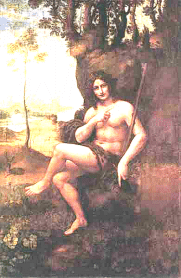
Dionysus
is often seen depicted holding a chalice and a wand called a “thyrsus”.
In Wicca/Witchcraft a wand or thyrsus is representative of the phallus of
the god, and the chalice as the womb of the goddess.
Therefore the thyrsus is the stalk and the seed, representing the shaft
of the phallus and the semen issuing forth.
The chalice is the opening to the womb and the lining of the uterus.
As Dionysus holds them both, he is symbolically displaying the male and
female polarities that when united will bring forth a Child of Promise.
In art
he is depicted wearing a crown of ivy, and covered in vine leaves and grapes, a
typical image of the Green Man. As
Bacchus he is bearded, more rustic in appearance and sporting horns, a typical
image of the Horned God. So here we
have in this one god, all the aspects of a traditional Wiccan God: he is a God of Nature and Lord of the Harvest, a God of the
Underworld, a Son/Lover of the Goddess, a Child of Promise, the Green Man and
the Horned God, all combined into one.
In
ancient Rome pictures of grapes were drawn or painted onto garden walls as a
symbol to ensure fertility in the garden. Eating
grapes or raisins increases fertility, as well as strengthening mental powers.
Placing grapes on the altar when conducting money spells will help and
aid in money matters. During ritual
wine is contained in the chalice and placed on the altar where it is used for
many purposes. It can be used to
symbolize the blood of the Goddess as a life giving essence, or to symbolize the
blood of the sacrificed God after his death and during his resurrection.
“Music is the wine which
inspires one to new generative processes, and I am Bacchus who presses out this
glorious wine for mankind and makes them spiritually drunken”
~ Ludwig van Beethoven.
Intoxication
though wine was thought to be the possession of the self by the spirit of the
vine, so to drink the wine during ritual was to merge oneself with the spirit of
the vine and thus with nature. The
wine is also used for toasting the deities in welcome and offerings of
libations. It is a common practice
in modern Wicca/Witchcraft to celebrate the conclusion of a full moon or sabbat
meeting with a meal of cakes and wine.
The
restorative and regenerative powers of the grape was known, used and revered by
the ancients of old. The warming
and fattening properties of grape sugar acts rapidly to increase strength and
repair waste in fevers, it is however unsuitable for gouty or inflammatory
conditions. The seeds and leaves of
the grapevine are astringent, and were used to stop hemorrhages and bleeding,
when boiled with Barley-meal and made into a poultice, it was also used to cool
the inflammation of wounds. Dried
and powdered leaves were used as a cure for dysentery in cattle.
The sap
of the vine taken from a cutting allowed to bleed, is often called a “tear”
or “lachrymal”, and makes an excellent lotion for weak eyes and specks on
the cornea. Ripe grapes eaten in
quantity can influence the kidneys to produce a free flow of urine, but care
should be taken when feeding excitable and full-blooded people, for too much
could cause palpitations. Dyspeptic
subjects should avoid eating them.
In cases
of anemia and in states of exhaustion, the restorative powers of the grape is in
a class of its own, especially when taken in conjunction with a light and
nourishing diet. In cases of
smallpox, grapes have proved useful owing to their bi-tartrate of potash
content, they are also said to benefit neuralgia and sleeplessness. The cuttings of the vine in spring can be boiled with sugar
into a syrup, taken inwardly this is an excellent stay for women’s longings
when pregnant.
People
that suffer from torpid liver and sluggish biliary functions should eat grapes
that are not quite fully ripe, whilst those with wasted tissue problems, should
eat fully ripe and sweet grapes. Dried
grapes or raisins are largely used in the manufacture of galenical medicines,
the seeds being separated and rejected as they give a very bitter taste.
Raisins are demulcent, nutritive and slightly laxative.
The ash of burnt vines was used as toothpaste to make discolored teeth
white again.
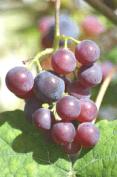
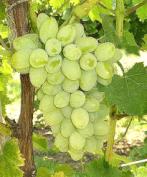
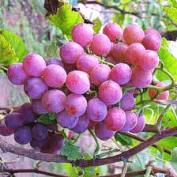
In
modern days the juice of the grape is rich in vitamins and minerals,
particularly iron. It provides a
source of instant energy and is ideal for convalescents.
The grape is laxative and diuretic and despite its sugar content, is not
fattening. Fasting using
grape-juice and grapes has been recommended by naturopaths to clear many chronic
diseases. Grapes are also used in
the treatment of poor blood circulation, low blood pressure, anaemia, liver
congestion and skin blemishes.
Through
its associations with nature, the underworld and reincarnation, the deities
associated with vines are numerous, and include: Dionysus, Bacchus, Hathor, Venus, Branwen, Aphrodite, Apollo
and Osiris. Its gender is feminine.
Its planet ruler is the Moon with strong associations to the Sun.
Its element is with Water, and its magickal associations promote: Fertility, Death and Rebirth, Garden Magick, Money, Mental
powers and Freedom of Spirit.
Astrologically
vine people (i.e. those born in the month of August) love tradition and are
happiest returning to places where they have had good times in the past. They
are sensual in nature but will defend their ideas and ideals passionately.
They care about nature and the preservation of the natural world, and
will risk life and limb in its defense.
Cunningham's Encyclopedia Of Magical Herbs - By Scott Cunningham.
Encyclopedia of Wicca & Witchcraft - By Raven Grimassi.
The Encyclopedia of Witches & Witchcraft - By Rosemary Ellen Guiley.
Tree Wisdom (The definitive guidebook to the myth, folklore and healing power of Trees) - By Jacqueline Memory Paterson.
AA Book of Britain's Countryside.
The Penguin Hutchinson Reference Library (CD cassette).
Microsoft Encarta
Encyclopedia (CD cassette).
Plus many websites to numerous to mention.
![]()
![]()

Let there be peace in the world - Where have all the flowers gone?
My Personal Page / My Place in England, UK / My Family Tree (Ancestry)
Wicca/Witchcraft / What is Wicca / What is Magick
Traditional Writings:
Wiccan Rede / Charge of the Goddess / Charge of the God / The Three-Fold Law (includes The Law of Power and The Four Powers of the Magus) / The Witches Chant / The Witches Creed / Descent of the Goddess / Drawing Down the Moon / The Great Rite Invocation / Invocation of the Horned God / The 13 Principles of Wiccan Belief / The Witches Rede of Chivalry / A Pledge to Pagan Spirituality
Correspondence Tables:
Incense / Candles / Colours / Magickal Days / Stones and Gems / Elements and Elementals
Traditions Part 1 - Alexandrian Wicca / Aquarian Tabernacle Church (ATC) / Ár Ndraíocht Féin (ADF) / Blue Star Wicca / British Traditional (Druidic Witchcraft) / Celtic Wicca / Ceremonial Magic / Chaos Magic / Church and School of Wicca / Circle Sanctuary / Covenant of the Goddess (COG) / Covenant of Unitarian Universalist Pagans (CUUPS) / Cyber Wicca / Dianic Wicca / Eclectic Wicca / Feri Wicca /
Traditions Part 2 - Gardnerian Wicca / Georgian Tradition / Henge of Keltria / Hereditary Witchcraft / Hermetic Order of the Golden Dawn (H.O.G.D.) / Kitchen Witch (Hedge Witch) / Minoan Brotherhood and Minoan Sisterhood Tradition / Nordic Paganism / Pagan Federation / Pectic-Wita / Seax-Wica / Shamanism / Solitary / Strega / Sylvan Tradition / Vodoun or Voodoo / Witches League of Public Awareness (WLPA) /
Gods and Goddesses (Greek
Mythology) / Esbats &
Full Moons / Links
to Personal Friends & Resources / Wicca/Witchcraft
Resources / What's a spell? /
Circle Casting and
Sacred Space / Pentagram
- Pentacle / Marks
of a Witch / The Witches
Power / The Witches Hat
/ An
esoteric guide to visiting London / Satanism
/ Pow-wow
/ The
Unitarian Universalist Association / Numerology: Part 1
/ Part 2 / Part
3 / A
history of the Malleus Maleficarum: includes: Pope
Innocent VIII /
The
papal Bull /
The
Malleus Maleficarum /
An extract from the Malleus Maleficarum
/ The letter of approbation
/ Johann
Nider’s Formicarius /
Jacob
Sprenger /
Heinrich Kramer /
Stefano Infessura
/ Montague Summers /
The Waldenses
/ The Albigenses
/
The Hussites / The
Sun Dance
/ Shielding (Occult
and Psychic Protection) /
Sabbats in History and Mythology / Samhain (October 31st) / Yule (December 21st) / Imbolc (February 2nd) / Ostara (March 21st) / Beltane (April 30th) / Litha (June 21st) / Lughnasadh (August 1st) / Mabon (September 21st)
Rituals contributed by Crone: Samhain / Yule / Imbolc / Ostara / Beltane / Litha / Lammas / Mabon
Tools of a Witch / The Besom (Broom) / Poppets and Dolls / Pendulums / Cauldron Magick / Mirror Gazing
Animals in Witchcraft (The Witches Familiar) / Antelope / Bats / Crow / Fox / Frog and Toads / Goat / Honeybee / Kangaroo / Lion / Owl / Phoenix / Rabbits and Hares / Raven / Robin Redbreast / Sheep / Spider / Squirrel / Swans / Wild Boar / Wolf / Serpent / Pig / Stag / Horse / Mouse / Cat
In Worship of Trees - Myths, Lore and the Celtic Tree Calendar. For descriptions and correspondences of the thirteen sacred trees of Wicca/Witchcraft see the following: Birch / Rowan / Ash / Alder / Willow / Hawthorn / Oak / Holly / Hazel / Vine / Ivy / Reed / Elder. Also see: The Willow Tree (Folk Music)
Mystical Sacred Sites - Stonehenge / Glastonbury Tor / Malta - The Hypogeum of Hal Saflieni / Avebury / Cerne Abbas - The Chalk Giant / Ireland - Newgrange /
Rocks and Stones:
Stones - History, Myths and Lore
Articles contributed by Patricia Jean Martin: / Apophyllite / Amber / Amethyst / Aquamarine / Aragonite / Aventurine / Black Tourmaline / Bloodstone / Calcite / Carnelian / Celestite / Citrine / Chrysanthemum Stone / Diamond / Emerald / Fluorite / Garnet / Hematite / Herkimer Diamond / Labradorite / Lapis Lazuli / Malachite / Moonstone / Obsidian / Opal / Pyrite / Quartz (Rock Crystal) / Rose Quartz / Ruby / Selenite / Seraphinite / Silver and Gold / Smoky Quartz / Sodalite / Sunstone / Thunderegg / Tree Agate / Zebra Marble
Wisdom:
Knowledge vs Wisdom by Ardriana Cahill / I Talk to the Trees / Awakening / The Witch in You / A Tale of the Woods
Articles and Stories about Witchcraft:
Murder by Witchcraft / The Fairy Witch of Clonmel / A Battleship, U-boat, and a Witch / The Troll-Tear (A story for Children) / Goody Hawkins - The Wise Goodwife / The Story of Jack-O-Lantern / The Murder of the Hammersmith Ghost / Josephine Gray (The Infamous Black Widow) / The Two Brothers - Light and Dark
Old Masters of Academia:
Pliny the Elder / Hesiod / Pythagoras
Abramelin the Mage / Agrippa / Aidan A. Kelly / Albertus Magnus “Albert the Great” / Aleister Crowley “The Great Beast” / Alex Sanders "the King of the Witches” / Alison Harlow / Amber K / Anna Franklin / Anodea Judith / Anton Szandor LaVey / Arnold Crowther / Arthur Edward Waite / Austin Osman Spare / Biddy Early / Bridget Cleary / Carl Llewellyn Weschcke / Cecil Hugh Williamson / Charles Godfrey Leland / Charles Walton / Christina Oakley Harrington / Damh the Bard (Dave Smith) / Dion Fortune / Dolores Aschroft-Nowicki / Dorothy Morrison / Doreen Valiente / Edward Fitch / Eleanor Ray Bone “Matriarch of British Witchcraft” / Dr. John Dee and Edward Kelly / Dr. Leo Louis Martello / Eliphas Levi / Ernest Thompson Seton / Ernest Westlake and the Order of Woodcraft Chivalry / Fiona Horne / Friedrich von Spee / Francis Barrett / Gerald B. Gardner / Gavin and Yvonne Frost and the School and Church of Wicca / Gwydion Pendderwen / Hans Holzer / Helen Duncan / Herman Slater "Horrible Herman" / Israel Regardie / James "Cunning" Murrell / Janet Farrar & Gavin Bone / Jessie Wicker Bell “Lady Sheba” / John Belham-Payne / John George Hohman / John Gerard / John Gordon Hargrave (the White Fox) / John Michael Greer / John Score / Johannes Junius the Burgomaster of Bamberg / Joseph John Campbell / Karl von Eckartshausen / Laurie Cabot "the Official Witch of Salem" / Lewis Spence / Margaret Alice Murray / Margot Adler / Marie Laveau the " Voodoo Queen of New Orleans" / Marion Weinstein / Matthew Hopkins “The Witch-Finder General” / Max Ehrmann and the Desiderata / Monique Wilson the “Queen of the Witches” / Montague Summers / Nicholas Culpeper / Nicholas Remy / M. R. Sellers / Mrs. Grieve "A Modern Herbal" / Oberon and Morning Glory Zell-Ravenheart / Old Dorothy Clutterbuck / Old George Pickingill / Paddy Slade / Pamela Colman-Smith / Paracelsus / Patricia Crowther / Patricia Monaghan / Patricia “Trish” Telesco / Philip Emmons Isaac Bonewits / Philip Heselton / Raymond Buckland / Reginald Scot / Robert Cochrane / Robert ‘von Ranke’ Graves and "The White Goddess" /
Rudolf Steiner / Rosaleen Norton “The Witch of Kings Cross” / Ross Nichols and The Order of Bards, Ovates & Druids / Sabrina - The Ink Witch / Scott Cunningham / Selena Fox / Silver Ravenwolf / Sir Francis Dashwood / Sir James George Frazer / S.L. MacGregor Mathers and the “Hermetic Order of the Golden Dawn” / Starhawk / Stewart Farrar / Sybil Leek / Ted Andrews / The Mather Family - includes: Richard Mather, Increase Mather, Cotton Mather / Thomas Ady / Vera Chapman / Victor Henry Anderson / Vivianne Crowley / Walter Brown Gibson / William Butler Yeats / Zsuzsanna Budapest
Many of the above biographies are brief and far from complete. If you know about any of these individuals and can help with aditional information, please cantact me privately at my email address below. Many thanks for reading :-)
While I have taken due care and dilligence to credit all sources where possible, this website may contain copyrighted material which has not been specifically authorized by the copyright owner. My use of making such material available here is done so in my efforts to advance our understanding of religious discrimination, the environmental and social justice issues etc. If you wish to use copyrighted material from this wedsite for purposes of your own then you must obtain permission from the relevant copyright owner yourself.
![]()
My online email discussion group:
http://groups.yahoo.com/group/Email_Witches

Help send a message of peace around the world! The Dove of Peace flies from site to site, through as many countries as possible. It does not belong to ANY belief system. Please help make a line around the globe by taking it with you to your site, by giving it to someone for their site, by passing it on to another continent or to the conflict areas of the world. May trouble and strife be vanquished in it's path.

mailto:George@controverscial.com
![]()
|
|